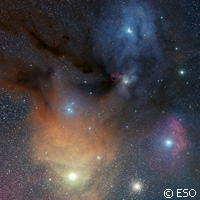Astronomers discover hydrogen peroxide in space
For the very first time, astronomers have discovered molecules of hydrogen peroxide in interstellar space. This new information, presented in the journal Astronomy & Astrophysics, could help scientists shed new light on the chemical link between water and oxygen, molecules that we know play a crucial role for life. Hydrogen peroxide is a highly reactive chemical, particularly important for the chemistry of water and ozone in Earth's atmosphere. And since a significant volume of water on Earth is believed to have formed initially in space, researchers are eager to provide insight on how it was created. The Atacama Pathfinder Experiment telescope (APEX), a venture bringing together the Max Planck Institute for Radio Astronomy (MPIfR) in Germany, the Onsala Space Observatory at Chalmers University of Technology in Sweden, and the European Southern Observatory (ESO), was used by the team to make their latest discovery. APEX is located on the Chajnantor plateau in the Chilean Andes. The astronomers detected a region in our galaxy close to the star Rho Ophiuchi, some 400 light years away. Not only is this region extremely cold, but it is home to dense clouds of cosmic gas and dust, and the emergence of new stars. While most clouds are hydrogen-based, other chemicals also exist. This in particular piques the interest of scientists who are seeking molecules in space. Experts believe that APEX, which is operated by ESO, is a solid tool as it can detect signals from these molecules. In this latest discovery, the astronomers found the characteristic signature of light emitted by hydrogen peroxide coming from part of the Rho Ophiuchi clouds. 'We were really excited to discover the signatures of hydrogen peroxide with APEX,' says lead author Per Bergman of Onsala Space Observatory. 'We knew from laboratory experiments which wavelengths to look for, but the amount of hydrogen peroxide in the cloud is just 1 molecule for every 10 billion hydrogen molecules, so the detection required very careful observations.' Researchers postulate that hydrogen peroxide is created in space when hydrogen is added to oxygen molecules on the surfaces of cosmic dust grains, which experts describe as being fine particles similar to sand and soot. Water can be produced with the further reaction of hydrogen peroxide and more hydrogen. According to the astronomers, their finding could fuel our understanding of how water is formed in the Universe. 'We don't understand yet how some of the most important molecules here on Earth are made in space,' explains Bérengère Parise, head of the Emmy Noether research group on star formation and astrochemistry at the Max Planck Institute for Radio Astronomy. 'But our discovery of hydrogen peroxide with APEX seems to be showing us that cosmic dust is the missing ingredient in the process,' adds the co-author. The team says this latest discovery could help piece together another interstellar puzzle: why is it so hard to find oxygen molecules in space? Oxygen molecules were first discovered in space in 2007 via the Odin satellite. The astronomers plan to conduct further observations of Rho Ophiuchi and other star-forming clouds in order to understand how the origins of these key molecules are linked.For more information, please visit: APEX:http://www.apex-telescope.org/Astronomy & Astrophysics:http://www.aanda.org/
Countries
Germany, Sweden



